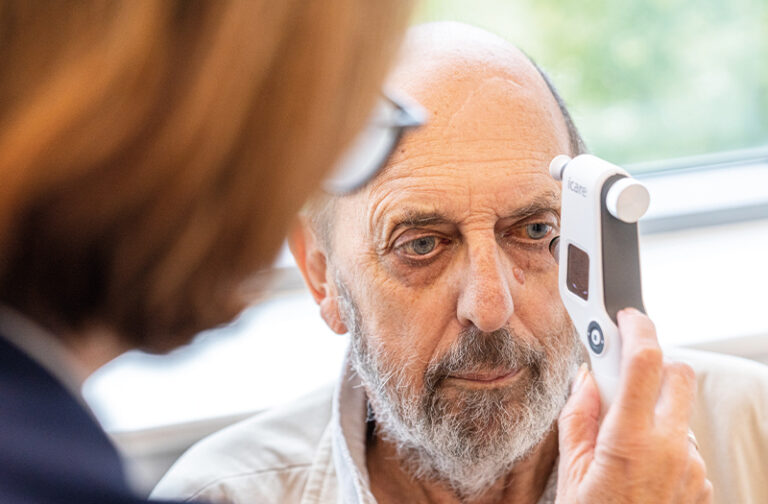Age-Related Macular Degeneration (AMD)
Age-Related Macular Degeneration (AMD) is one of the leading causes of sight loss in the developed world and affects more than 600,000 people in the UK. It can cause gaps or dark spots across your vision and make straight lines look wavy or bent. When you’re reading, words may appear distorted or jumbled on the page.
There are two types of AMD – wet and dry.

Wet AMD
Wet AMD develops when abnormal blood vessels leak into the macular (this is the small central point of the retina, which is responsible for our central vision) and cause scarring and loss of central vision. It can develop rapidly, but can be treated if caught quickly enough. Most people will receive a course of treatment where a special drug called anti-VEGF is injected into the eye to slow down the growth of new blood vessels. This might sound daunting, but you won’t feel any pain, as you’ll be given anaesthetic eye drops to numb the eye and the needle used for the injection is tiny – just 12mm (½ inch) long.

Dry AMD
Dry AMD is a slow deterioration of the cells of the macular. There is no currently accepted treatment available on the NHS for dry AMD, but if your condition is diagnosed early enough, you can take steps to help slow down its progression, such as taking vitamin supplements, having a healthy diet and not smoking.
Whether you’re a patient in need of wet AMD treatment, or a relative/family friend looking for more information about AMD, our Patient Journey provides a step-by-step guide to every stage of treatment, so you know exactly what to expect along the way.
Causes and symptoms
Age-related macular degeneration (AMD) is a common condition that affects the middle part of your vision and may compromise your ability to carry out everyday tasks like reading, watching TV and recognising faces. If you have AMD, you may notice that things start to look blurry, lines appear wavy or crooked, there are gaps or dark spots in your vision, and colours aren’t as bright as they used to be.
AMD develops with age, and while it’s more commonly seen in people age 65+, it can also develop at ages 40 – 50. The exact cause is unknown, although it’s more common in smokers, people with high blood pressure or a poor diet, and people who have a family history of AMD. Research has also shown that people who are regularly exposed to sunlight without adequate protection are more at risk of developing AMD, and the condition is more prevalent in women than men.
It’s possible to get AMD in one or both of your eyes.
Dry AMD is caused by a build-up of a fatty substance at the back of your eye, which causes your vision to gradually decline over the course of several years and, unfortunately, there’s currently no treatment or cure for it. However, if your condition is diagnosed early enough, you can take steps to help slow its progression, such as taking vitamin supplements, having a healthy diet and not smoking.
Wet AMD is caused by the growth of abnormal blood vessels at the back of your eye. The onset of wet AMD happens much more quickly and can cause your vision to deteriorate within a matter of weeks or months. It’s possible to slow down the progression of wet AMD, but you will need treatment at regular intervals to prevent your vision from getting worse.
We know a diagnosis of AMD can be daunting, but we’re here to support you every step of the way and answer any questions you have.
AMD Treatment at SpaMedica
The following SpaMedica hospitals provide treatment for Age-Related Macular Degeneration: Belfast, Birmingham, Carlisle, Chelmsford, Chester, Coventry, Colchester, Gateshead, Haydock, Manchester, Newcastle-Under-Lyme, Newark, North Tyneside, Peterborough, Romford, Sittingbourne, Solihull, Stockton-on-Tees, West Lancashire, Widnes, Wirral.
-

Diagnosis and referral
If you’re experiencing any of the symptoms of AMD, please get your eyes checked by your local optician – here’s how get a formal diagnosis and referral for treatment.
AMD patients -

Pre-op Assessment
This page tells you what to expect during your first appointment with us, where you’ll undergo some non-invasive eye tests in preparation for your AMD treatment.
AMD patients

